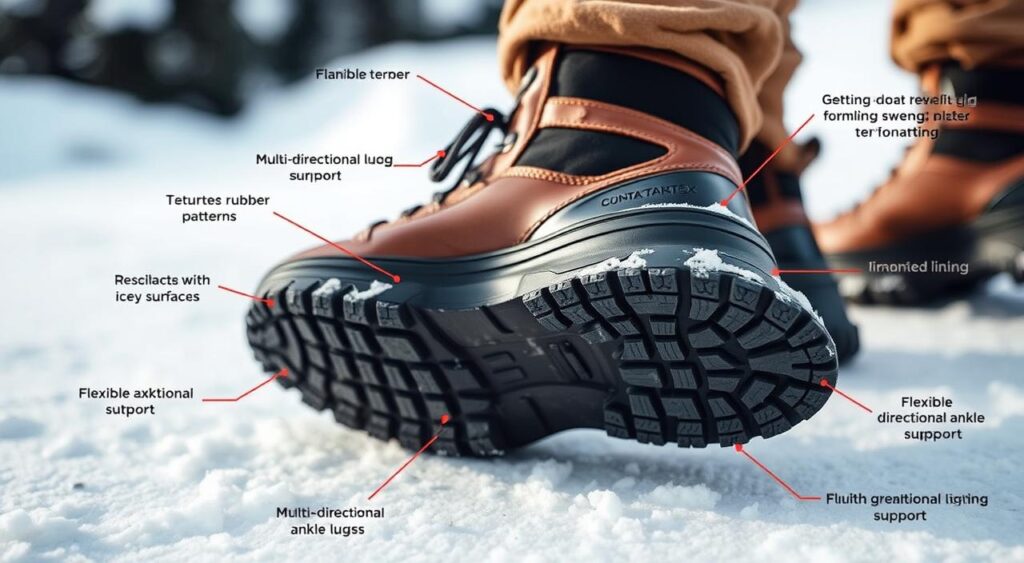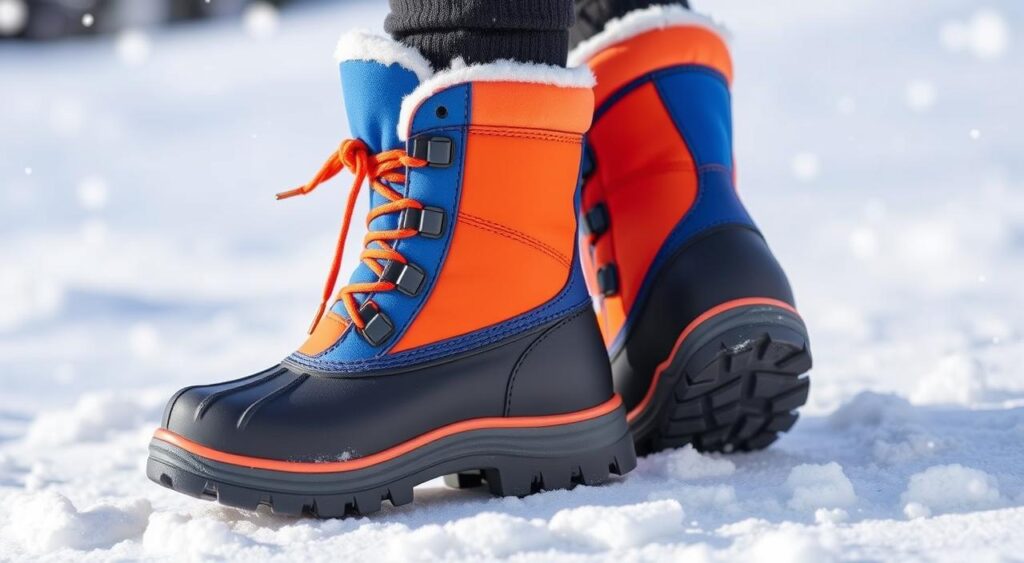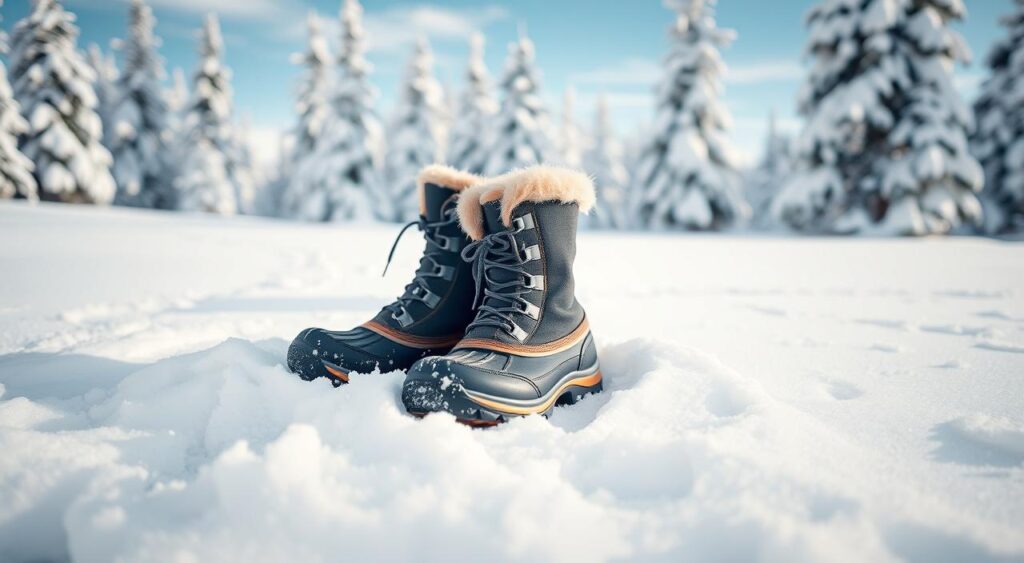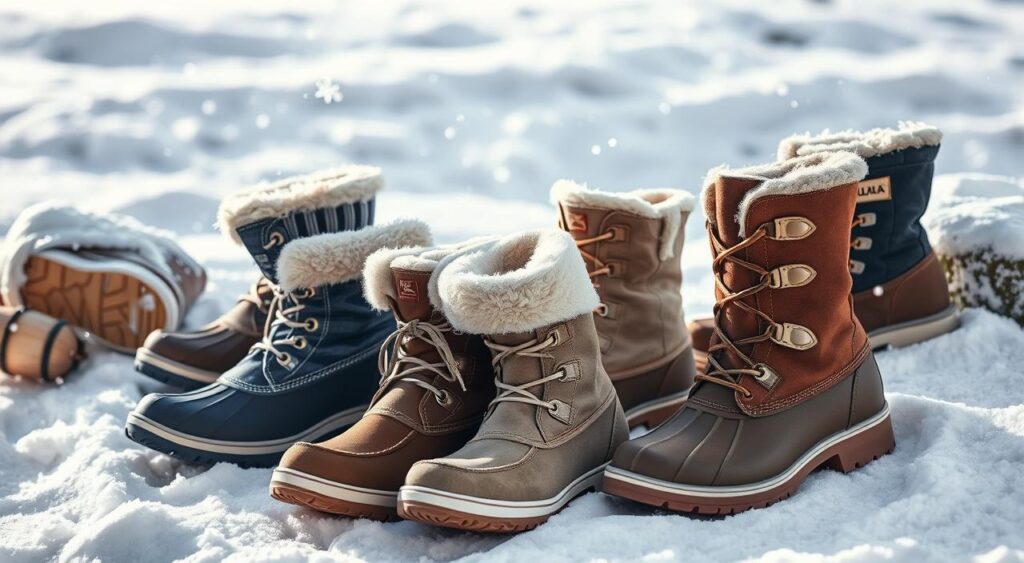Choosing the right snow boots for beginners is key to staying warm and dry in winter. This guide will help you pick the best insulated boots, waterproof boots, and traction boots. You’ll learn about top snow boot brands, temperature ratings, and important features like boot height, liners, and maintenance. This ensures your feet stay warm and dry in cold, snowy weather.
Table of Contents
Understanding Snow Boot Essentials
Right snow boots are crucial for snowy terrain. Look for waterproofing and insulation. Waterproof materials like rubber keep your feet dry. Insulation, like synthetic fill or wool, keeps you warm.
Choosing the right waterproofing and insulation depends on your winter activities. This ensures you pick the best snow boots.
Traction and Grip
Traction and grip are vital for snow boot traction and safety. Boots with rugged, lugged rubber soles are best. They help you stay stable on icy and snowy surfaces.
The sole pattern is also important. Features like deep grooves and wide, flexible lugs help with grip on ice and snow.
| Feature | Importance | Example |
|---|---|---|
| Waterproofing | Keeps feet dry in wet snow and slush | Waterproof membranes, rubber |
| Insulation | Maintains warmth in cold temperatures | Synthetic fill, wool liners |
| Traction and Grip | Provides stability and control on ice and snow | Lugged rubber soles, deep grooves |
“Investing in a quality pair of waterproof snow boots with the right insulation for snow boots and sole patterns for snow boots can make all the difference in your winter adventures.”
Determining Your Winter Boot Needs
Choosing the right snow boots depends on how you plan to use them. For casual wear, like running errands, a lightweight boot is good. But for outdoor activities like hiking, you need boots that keep your feet warm and dry.
Casual Wear vs. Outdoor Activities
For everyday wear, a boot with a shaft of 8 to 10 inches is best. Look for features like reflective layers to keep you warm. Boots with nubby lugs on the bottom are great for icy surfaces.
Outdoor activities require boots that fit well for stability. Lace-up boots are better than slip-ons for icy surfaces. The Kamik Nation Plus is great for cold weather, and the Columbia Heavenly Omni-Heat is stylish and warm.
For a mix of style and function, consider the Ugg Adirondack III and Ugg Butte. They’re pricey but comfortable. The Sorel Caribou Boot is best for wet weather.
Knowing how you’ll use your boots helps choose the right pair. This ensures your feet stay comfortable, whether you’re in the city or outdoors.
Top Snow Boot Brands for Beginners
Looking for the best snow boots for beginners? Several top brands are great for quality and performance. Kamik, Sorel, The North Face, and Baffin are highly recommended. They are known for their durability and ability to handle winter conditions well.
The Kamik Nation Plus boot can handle -40°F/-40°C temperatures. It’s perfect for those new to snow boots. The Sorel Caribou Boot is also a good choice. It’s weatherproof thanks to its gusseted tongue, ideal for outdoor activities.
For a stylish option, check out the Baffin Cloud line. These boots are fashionable and have a 13.5-inch shaft height. They also have a soft rubber blend sole for better traction.
Prices vary among these brands. The The North Face Chilkat V 400 costs $159. The Kamik Nation Plus is $100, and the Sorel Caribou Boots are $200. The Merrell Thermo Chill Mid is $130, and the Baffin Impact Boots are $260.
These brands offer reliable, high-quality options for beginners. They keep your feet warm, dry, and stable all winter.
| Brand | Model | Temperature Rating | Shaft Height | Price |
|---|---|---|---|---|
| Kamik | Nation Plus | -40°F/-40°C | N/A | $100 |
| Sorel | Caribou Boot | -40°F/-40°C | N/A | $200 |
| The North Face | Chilkat V 400 | N/A | N/A | $159 |
| Baffin | Cloud (Women’s) | N/A | 13.5 inches | More than twice the men’s pick |
| Merrell | Thermo Chill Mid | N/A | N/A | $130 |
| Baffin | Impact Boots | N/A | N/A | $260 |
Assessing Warmth and Temperature Ratings

When choosing snow boots, warmth is key. Snow boot temperature ratings help, but they have limits. These ratings show the lowest temperature the boots are made for.
But remember, these ratings are just estimates. They don’t always match your personal cold tolerance or activities. Insulation, boot construction, and body chemistry also affect warmth.
To check a snow boot’s warmth, look at the insulation and weight. Boots with more insulation, measured in grams per square meter, keep feet warmer. The insulation type, like synthetic or down, also matters for heat retention.
The boot’s construction also impacts warmth. Boots with a thick, waterproof outer layer and good lining keep heat better. Look for wind-blocking panels and extra insulation in the toes and ankles.
The best way to know a snow boot’s warmth is to wear it in your conditions. Notice how your feet feel. To discover the ideal fit, try on various footwear.
“The right snow boots can make all the difference in keeping your feet warm and comfortable during the winter months.”
Choosing the Right Boot Height
When picking snow boots, height matters a lot. You can choose from ankle-high to knee-high, each with its own benefits. Knowing about these options helps you pick the best for you.
Ankle vs. Mid-Calf vs. Knee-High
Ankle-high boots are great for moving around easily. They’re perfect for casual days or light outdoor fun. But, they don’t protect as much from snow, slush, and wind.
Mid-calf boots offer a good mix of protection and freedom. They keep you safe from the cold while still letting you move well. These boots are good for many winter tasks, like running errands or easy hikes.
Knee-high boots give you the most protection. They keep your legs warm and dry in harsh weather. They’re best for tough tasks like shoveling snow or walking through deep snow.
The right boot height depends on the weather, what you plan to do, and what you like. Think about the temperature, how much rain or snow there is, and how much protection you need. This will help you choose the best boots for you.
Factors Affecting Traction and Grip

Walking on icy, snowy, and slippery surfaces in winter requires good traction and grip. The design of the sole, with features like deep lugs and flexible materials, is key. Also, the type of material used in the sole greatly affects how well the boots grip.
Sole Patterns and Materials
Choose snow boots with soles that have deep, wide lugs. These help prevent snow and ice from sticking, making it easier to stay on your feet. Boots with flexible, rubber soles also grip better than stiff or smooth ones. A good sole pattern and rubber material are essential for tackling winter’s slippery surfaces.
| Traction Feature | Description | Benefits |
|---|---|---|
| Deep Lugs | Pronounced, widely spaced treads on the sole | Prevent snow and ice buildup, improve grip on slippery surfaces |
| Flexible Rubber Soles | Rubber-based compound that allows the sole to bend and conform to the terrain | Increases surface contact and traction on uneven, icy ground |
By focusing on the sole’s design and materials, you can find boots that keep you stable and secure in winter’s toughest conditions.
Fitting and Trying on Snow Boots
Finding the right fit is key for comfort and performance in snow boots. Wear the socks you plan to wear with them. Make sure your toes have a bit of room but not too much.
The boot should feel snug in the heel and secure around your ankle. It should not pinch or rub. Check if the boot supports your foot well and if there are any uncomfortable spots.
Wear just one pair of socks when trying on boots. This helps avoid pressure points and keeps your feet warm. Choose socks that wick away moisture for comfort.
Try on different styles to find the best fit. Snow boots are made to fit snugly over thick socks. Avoid sizing up too much, as this can cause tripping.
Do the kick test to see if your toes hit the front. Check the heel space by slipping your finger down the back. Your toes should have enough room to wiggle.
| Boot Type | Price Range |
|---|---|
| Women’s Snow Boots | $249.99 – $700.00 |
| Alpine Touring Boots | $249.99 – $875.00 |
For wide or narrow feet, try on various styles. This ensures you find the perfect fit for your adventures.
“Properly fitting snow boots should offer both support and insulation, balancing warmth and comfort with proper circulation and walking functionality.”
Snow Boots for Beginners

Starting out with winter footwear can be a big step. The right snow boots are key to staying warm, dry, and safe. Look for insulation, waterproofing, and good traction in your first pair.
Brands like Kamik, Sorel, and The North Face make great snow boots. They offer warmth and quality, keeping your feet cozy in cold weather.
Waterproofing is also important for new snow boot owners. Choose boots with waterproof materials and sealed seams. This keeps your feet dry and warm, so you can enjoy the outdoors.
Don’t forget about traction and grip. Boots with slip-resistant soles and deep lugs help you stay steady on icy or snowy ground. This prevents falls and keeps you moving.
Focus on warmth, waterproofing, and traction to find the best beginner’s snow boots. These features will keep you comfortable and secure all winter.
Waterproofing and Breathability Considerations
When picking waterproof snow boots, finding the right mix of waterproofing and breathability is key. Waterproofing keeps your feet dry in wet conditions. But, you also need breathability to avoid sweaty, uncomfortable feet.
Choose boots with Gore-Tex or similar technology. These materials let moisture out, keeping your feet dry and comfy. Breathable snow boots are great for active outdoor fun, where you sweat more.
Waterproof snow boots might cost more and be heavier than non-waterproof ones. But, they offer better protection and comfort. Non-waterproof shoes, however, breathe better, helping sweat evaporate.
Boots’ waterproofing can wear off over time, especially with dirt and grime. Cleaning and conditioning them regularly helps keep them waterproof and breathable.
Think about your activities and the weather when picking snow boots. For really cold and wet days, go for insulated, waterproof snow boots that breathe a bit. For milder weather or less intense activities, a breathable, water-resistant option might be enough.
Boot Liners and Removable Insulation

Many snow boots come with removable liners or insulation. This offers several benefits for winter explorers. You can adjust the warmth in your boots for different activities or weather. It also makes drying out boots easier, helping them last longer.
Some boots let you swap out snow boot liners when they wear out. This is great for people who do many outdoor activities. It’s perfect for everything from removable insulation in snow boots to just walking around in winter.
| Boot Model | Weight | Temperature Range | Insulation | Liner | Price |
|---|---|---|---|---|---|
| Salomon Tundra | 1 lb 7 oz | -40 to 40°F | Foam | Removable Foam Liner | $200.00 |
| Baffin Borealis | 3 lbs | -40 to 40°F | Foam | Removable Foam Liner | $140.00 |
| Baffin Summit | 3 lbs 7 oz | -40 to 40°F | Foam | Removable Foam Liner | $200.00 |
Despite the benefits of removable liners, some models, like the Salomon Tundra, have leak issues. To fix this, using 3 mm thick closed-cell neoprene divers’ socks as a vapor barrier can help keep feet warm and dry.
Some people have also customized their boots. They’ve replaced the liners with wool felt for more comfort and warmth. Others, like Sorel Caribou boot users, have improved their boots by removing the felt liner and adding down booties with heavy wool socks for better fit and insulation.
Snow Boot Care and Maintenance Tips
Keeping your snow boots in good shape is key. Regular cleaning, drying, and conditioning help a lot. This way, your boots stay waterproof, durable, and ready for your next adventure.
Cleaning and Drying
After wearing, clean your boots with a soft-bristle brush and mild soap and water. This removes dirt, salt, and debris. Make sure to rinse them well and dry them completely before storing.
Moisture can cause mold or damage. So, let your boots air-dry or use a boot dryer to make sure they’re dry.
Storage and Conditioning
When not in use, keep your boots somewhere dry and cold. Stuff them with acid-free tissue paper or boot forms to keep their shape. This prevents sagging or stretching.
Also, condition the materials like leather or nubuck with a dedicated conditioner. This keeps them soft and weatherproof.
| Care Step | Frequency | Importance |
|---|---|---|
| Cleaning with Mild Soap and Water | After Each Use | Removes dirt, salt, and debris to prevent damage |
| Thorough Drying | After Cleaning | Prevents mold, mildew, and material degradation |
| Conditioning Leather/Nubuck | Seasonally | Maintains suppleness and waterproofing |
| Proper Storage in Cool, Dry Place | When Not in Use | Preserves shape and protects from environmental factors |
By following these easy tips, you can keep your snow boots in great condition. This ensures they protect, comfort, and last for many seasons.
Conclusion
Choosing the right snow boots is key to staying warm and dry in winter. Look for features like waterproofing, insulation, and traction. Think about what you need and how you’ll use them.
Try on different boots to find the best fit. Also, take care of your boots to make them last. With the right boots, you can enjoy the outdoors all winter.
Whether you’re new to winter or a seasoned pro, this article has tips for picking the best snow boots. You’ll be ready for your next cold-weather adventure.
